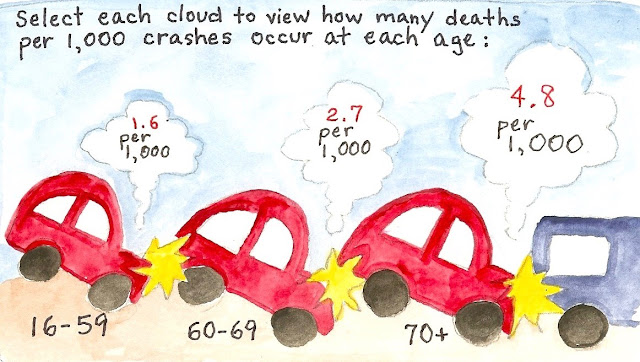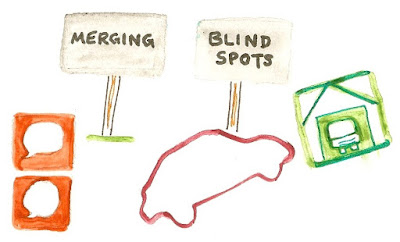Driver Ed in our First Third: harrowing films of terrible car accidents, screeching brakes, bodies burnt to crisps.
Driver Ed in our Third Third: harrowing statistics like, “Seniors aged 65 and over are more than twice as likely as younger drivers to be killed when involved in a crash;” that we need 20 times more light to see at night at age 40 than at age 20; that deaths in crashes start increasing around ages 60-64.
I decided to click on all those AARP emails about saving 30% for a limited time only – with a promo code! – on the Smart Driver™ online course so I’d get an insurance discount. It looked easy enough: there were six units, and it would take about four hours. I could do it on my own schedule.
The man and the woman instructors said this was all about change: we and our bodies are changing, our cars are changing, and road conditions are changing. It became clear that I wasn’t the only one in my Third Third: my 2001 Subaru was in its Third Third. It doesn’t have half the gizmos new cars have. Gizmos may make driving safer, but gizmos apparently also add to the confusion.
Right off, the novelty impressed me. The instructors switched from video to PowerPoint-looking things, to little interactive games. I had to click on the little clouds to see how many deaths per 1,000 crashes occur at each age.
Right away, we hit my personal fear factor: vision. Older drivers have trouble with glare, with switching from looking out the windshield to looking at the dashboard, to seeing contrast. I already know dusk is the roughest time for me driving. In a car, I’ve learned it’s hard to switch from the road to the cheat sheet with my directions written on it.
I’ve written about my “Agony at the Eye Doctor,” but this course put eye doctor agony in my car. They described a vision test I’d never even had: contrast sensitivity. I’d better tell my eye doctor about that. I have a new thing to worry about.
But vision wasn’t enough: we had to move on to the big fear factor: brain health. As we age, we experience changes in “memory, processing speed, attention, and brain regulation skills – overall executive function” – Oh, no! She named the nightmares! If driving is a complex balancing act, “the idea that our mind isn’t working as well as it used to can be frightening.” You think?
Okay, a bit of First Third explanation: As a teenager, the week before my road test for a driver’s license, I was out practicing with my mother. At the top of a hill, an inattentive driver was on the wrong side of the road and rammed into me head-on. In a big old Buick, the engine sat in the front seat with us, and my face went into the steering wheel.
I decided I wasn’t going to drive. Ever. Cars were tons of weaponry on the road, and “other guys” were everywhere.
This continued for a couple years until my parents were tired of chauffeuring me everywhere. So I learned to drive. Unwillingly. Hence, a happy career in public transit and a love affair with buses and street cars.
Living in Anchorage, having a child, having to be places – driving is what I do now. It’s what my mother did, too, which worried her kids a lot. The course talks about that, about how to have The Conversation with a person who shouldn’t be driving.
Mostly, the course upped my attention, always a good thing. Meanwhile, I got to click on icons, click on highway signs, and click on talk bubbles. I got to move the car into the right garage. I wouldn’t call it a video game, but I did win dollars off on my car insurance.





I didn't know about this course, or the statistics for older drivers, or the insurance discount. Thanks for sharing.
ReplyDelete